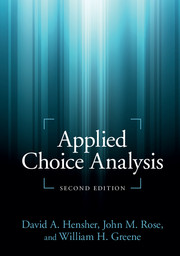10 - Data set up for Nlogit
from Part II - Software and data
Published online by Cambridge University Press: 05 June 2015
Summary
Reading in and setting up data
In teaching courses on discrete choice modeling, we have increasingly observed that many participants struggle with the look of choice data. Courses and texts on econometrics often provide the reader with an already formatted data set (as does this book) yet fail to mention how (and why) the data were formatted in the manner they were. This leaves the user to work out the whys and the hows of data formatting by themselves (albeit with the help of lists such as the Limdep List: see http://limdep.itls.usyd.edu.au). The alternative is for the non-expert to turn to user manuals; however, such manuals are often written by experts for experts. We have found that even specialists in experimental design or econometrics have problems in setting up their data for choice modeling.
We now focus on how to format choice data for estimation purposes. We concentrate on data formatting for the program Nlogit from Econometric Software. While other programs capable of modeling choice data exist in the market, we choose to concentrate on Nlogit because this is the program that the authors are most familiar with (indeed Greene and Hensher are the developers of Nlogit). Nlogit also offers all of the discrete choice models that are used by practitioners and researchers. The release of Nlogit5.0 in August 2012 came with a comprehensive set of (four) online manuals (and no hard copy manuals). The discussion here complements the manuals. All the features of Nlogit that are used here are available in version 5.0 (dated September 2012).
- Type
- Chapter
- Information
- Applied Choice Analysis , pp. 400 - 434Publisher: Cambridge University PressPrint publication year: 2015
- 1
- Cited by

